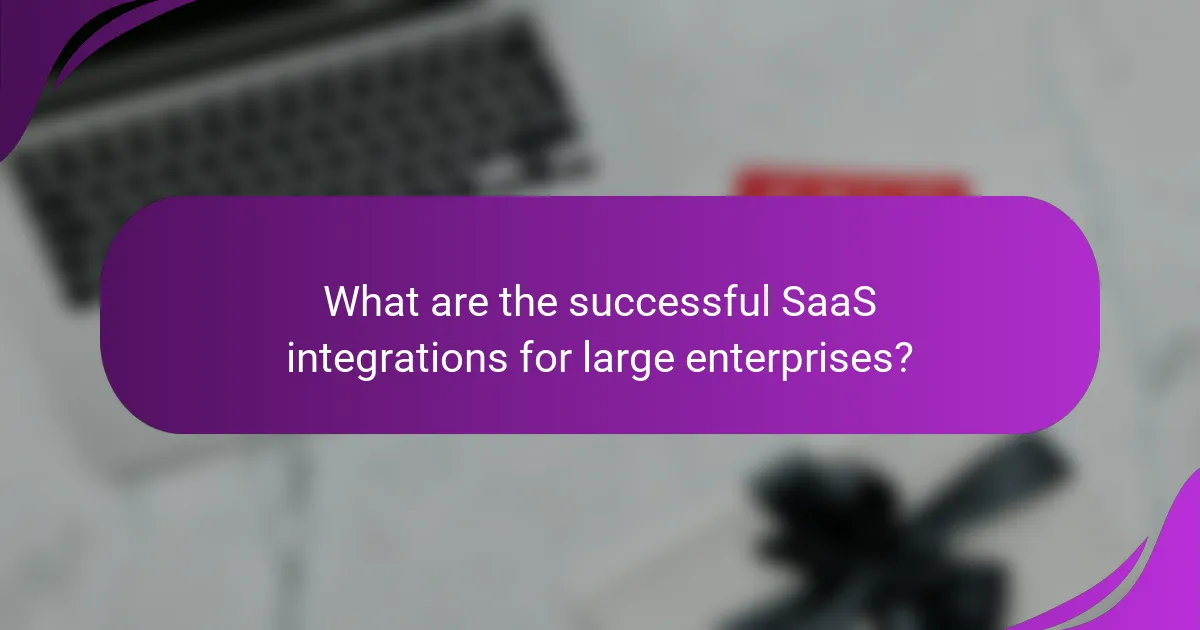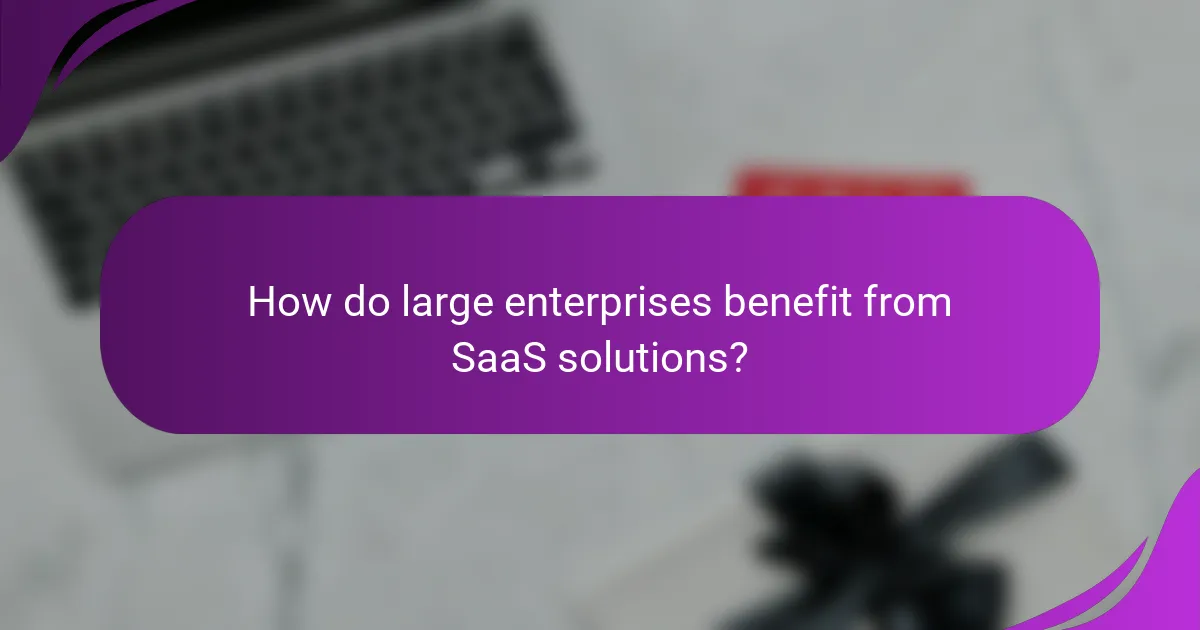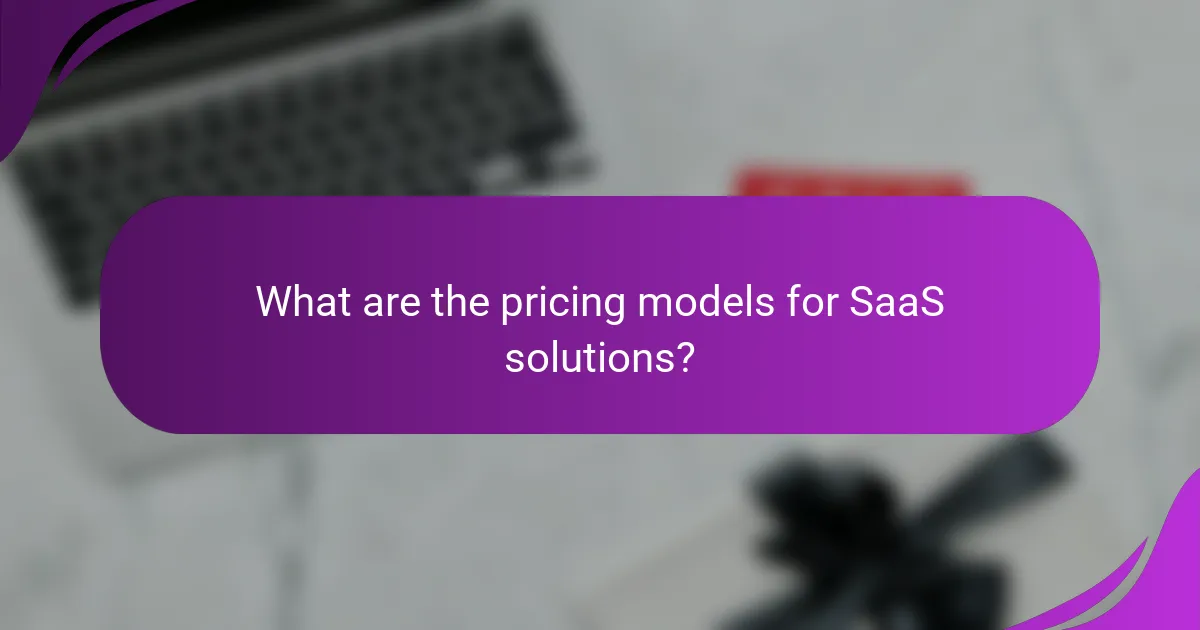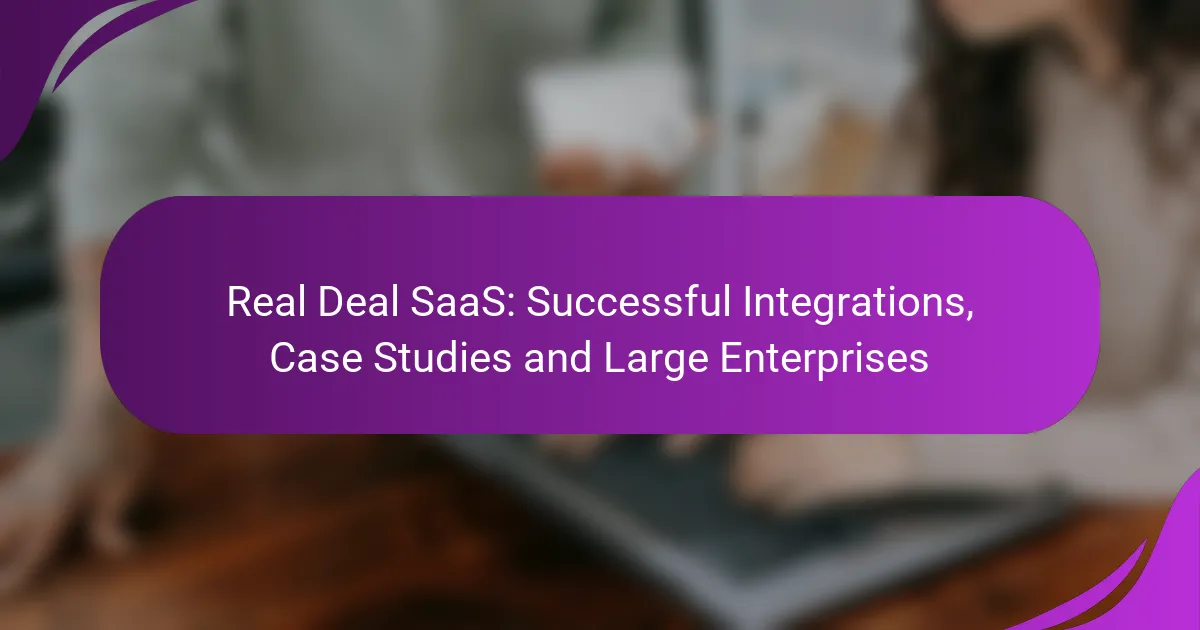In today’s fast-paced business environment, successful SaaS integrations are essential for large enterprises seeking to streamline operations and enhance collaboration. By connecting various software applications, these integrations facilitate seamless data flow, leading to increased productivity and improved data management. Notable case studies demonstrate how organizations leverage cloud-based solutions to drive growth and adapt to market demands, showcasing the tangible benefits of effective SaaS implementations.

What are the successful SaaS integrations for large enterprises?
Successful SaaS integrations for large enterprises streamline operations, enhance collaboration, and improve data management. These integrations connect various software applications, enabling seamless data flow and increased productivity across departments.
Salesforce and HubSpot integration
The integration of Salesforce and HubSpot allows businesses to align their marketing and sales efforts effectively. By syncing data between these platforms, teams can track leads, manage customer relationships, and automate marketing campaigns.
Key considerations include ensuring data consistency and establishing clear workflows. For example, leads captured in HubSpot can be automatically transferred to Salesforce, allowing sales teams to act quickly on potential opportunities.
To maximize this integration, regularly review your data mapping and ensure that both platforms are updated to leverage new features and capabilities.
Slack and Microsoft Teams integration
Integrating Slack with Microsoft Teams facilitates communication across different teams and departments that may prefer one platform over the other. This integration allows users to send messages and share files between the two applications, reducing silos in communication.
When implementing this integration, consider the user experience and training needs. For instance, setting up channels that mirror each platform can help users navigate easily. Additionally, ensure that notifications are managed to prevent overload.
Regularly assess the integration’s effectiveness by gathering feedback from users and adjusting settings to improve collaboration.
Zapier for workflow automation
Zapier serves as a powerful tool for workflow automation, connecting thousands of apps to automate repetitive tasks. Large enterprises can use Zapier to create “Zaps” that trigger actions across different software without needing extensive coding knowledge.
For example, a Zap can automatically add new leads from a web form into a CRM like Salesforce or send email notifications when specific conditions are met. This can save time and reduce the risk of human error.
To effectively use Zapier, start with a clear understanding of your workflows and identify repetitive tasks that can be automated. Regularly review and optimize your Zaps to ensure they continue to meet your evolving business needs.

How do large enterprises benefit from SaaS solutions?
Large enterprises benefit from SaaS solutions by gaining access to cost-effective, scalable, and efficient software that enhances their operational capabilities. These solutions allow organizations to streamline processes, reduce overhead costs, and adapt quickly to changing market demands.
Cost reduction and efficiency
SaaS solutions significantly lower costs for large enterprises by eliminating the need for extensive hardware investments and ongoing maintenance. Instead of purchasing software licenses, companies typically pay a subscription fee, which can lead to savings of up to 30% compared to traditional software models.
Additionally, SaaS applications often come with automatic updates and support, reducing the burden on IT teams and allowing them to focus on strategic initiatives rather than routine maintenance. This efficiency translates into faster deployment times and quicker access to new features.
Scalability and flexibility
Scalability is a key advantage of SaaS for large enterprises, as these solutions can easily accommodate growth without requiring significant infrastructure changes. Companies can quickly adjust their subscription plans to match their current needs, whether that means adding more users or expanding functionality.
This flexibility allows businesses to respond to market fluctuations and project demands without the risk of overcommitting resources. For example, a seasonal business can scale its SaaS usage up or down as needed, optimizing costs throughout the year.
Enhanced collaboration and communication
SaaS solutions foster improved collaboration and communication among teams, regardless of their physical locations. Tools like cloud-based document sharing and real-time messaging platforms enable employees to work together seamlessly, enhancing productivity and innovation.
Moreover, these applications often integrate with other tools, creating a unified ecosystem that supports various workflows. For instance, a large enterprise might use a SaaS project management tool that connects with its CRM and email systems, streamlining processes and ensuring everyone is on the same page.

What are notable case studies of SaaS success?
Notable case studies of SaaS success highlight how companies leverage cloud-based solutions to enhance operations, improve scalability, and drive growth. These examples illustrate effective integrations and the tangible benefits realized by large enterprises.
Netflix’s use of AWS
Netflix transitioned to Amazon Web Services (AWS) to support its streaming service, allowing it to scale efficiently and handle millions of concurrent users. This integration enabled Netflix to utilize a global network of data centers, ensuring high availability and low latency for viewers worldwide.
By adopting AWS, Netflix reduced its infrastructure costs and improved its ability to deploy new features rapidly. The flexibility of AWS services allowed Netflix to experiment with different technologies, enhancing its content delivery and user experience.
Spotify’s integration with Google Cloud
Spotify partnered with Google Cloud to enhance its data analytics capabilities and improve its music streaming service. This integration allowed Spotify to leverage Google’s machine learning tools, enabling personalized recommendations and better user engagement.
The move to Google Cloud also provided Spotify with robust security features and improved performance, helping the company manage its vast music library and user base effectively. This partnership illustrates how cloud solutions can drive innovation in the music industry.
Zoom’s rapid growth during the pandemic
Zoom experienced explosive growth during the COVID-19 pandemic as remote work surged. The platform’s SaaS model allowed it to scale quickly to accommodate millions of new users, providing seamless video conferencing solutions for businesses and individuals alike.
Zoom’s success can be attributed to its user-friendly interface and reliable performance, which made it a go-to choice for virtual meetings. The company also adapted its offerings by introducing features like breakout rooms and enhanced security measures to meet the evolving needs of users during this unprecedented time.

What criteria should enterprises consider when choosing a SaaS solution?
Enterprises should evaluate several key criteria when selecting a SaaS solution, including integration capabilities, security and compliance standards, and customer support. These factors ensure that the chosen software aligns with business needs and can operate effectively within existing systems.
Integration capabilities
Integration capabilities refer to how well a SaaS solution can connect with other software and systems. Look for solutions that offer APIs, pre-built connectors, or support for common integration platforms to streamline workflows and data sharing.
Consider the ease of integration and the potential need for custom development. Solutions that provide extensive documentation and community support can significantly reduce implementation time and costs.
Security and compliance standards
Security and compliance are critical when choosing a SaaS solution, especially for enterprises handling sensitive data. Ensure the provider adheres to recognized standards such as ISO 27001 or GDPR for European operations, which govern data protection and privacy.
Evaluate the security features offered, including data encryption, access controls, and regular security audits. A transparent security policy and incident response plan are also essential to mitigate risks.
Customer support and service levels
Customer support and service levels can greatly impact the user experience and operational efficiency. Look for providers that offer 24/7 support, multiple contact methods (such as chat, email, and phone), and a comprehensive knowledge base.
Assess the service level agreements (SLAs) to understand response times and resolution commitments. High-quality support can help resolve issues quickly, minimizing downtime and enhancing productivity.

What are the pricing models for SaaS solutions?
SaaS solutions typically utilize various pricing models to accommodate different business needs and usage patterns. The most common models include subscription-based pricing and usage-based pricing, each with its own advantages and considerations.
Subscription-based pricing
Subscription-based pricing involves charging customers a recurring fee, usually monthly or annually, for access to the software. This model provides predictable revenue for providers and allows users to budget their expenses effectively.
Common subscription tiers may offer different features or levels of service, enabling businesses to choose a plan that aligns with their needs. For example, a basic plan might cost around $10 to $50 per month, while premium plans could range from $100 to several hundred dollars, depending on the features included.
Usage-based pricing
Usage-based pricing charges customers based on their actual usage of the software, making it a flexible option for businesses with fluctuating needs. This model can be beneficial for companies that want to avoid paying for unused capacity.
For instance, a cloud storage service might charge customers $0.10 per gigabyte stored, allowing businesses to scale their costs according to their data needs. However, it’s essential to monitor usage closely to avoid unexpected charges, especially during peak periods.
